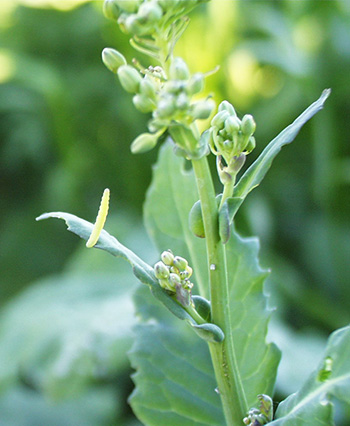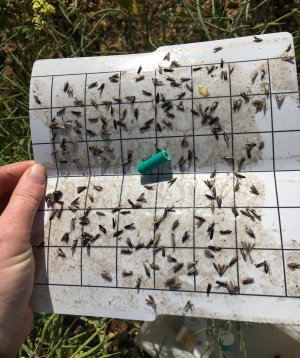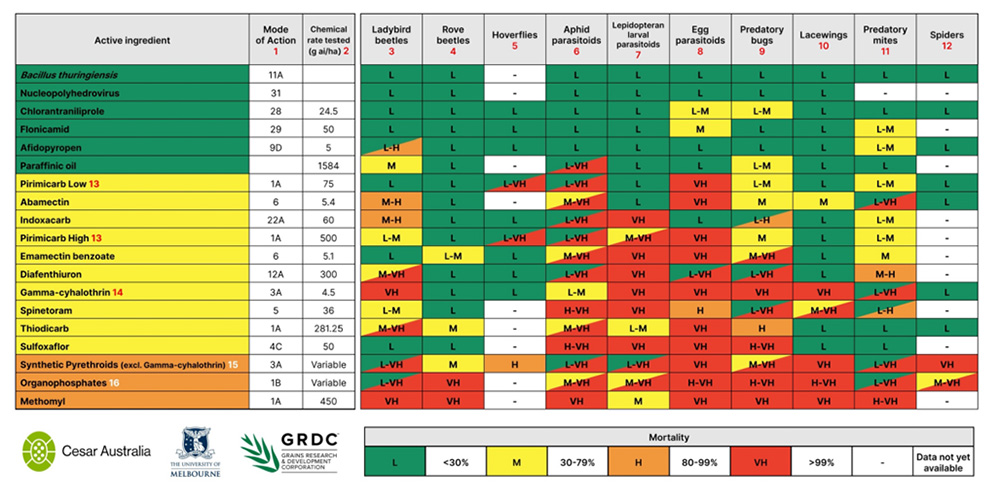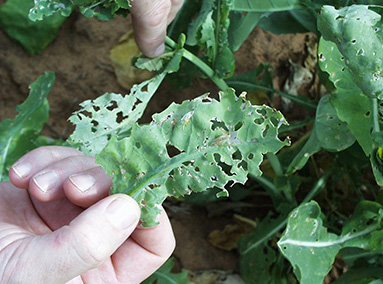Paddock Practices: Managing diamondback moth
Paddock Practices: Managing diamondback moth
Date: 06 Sep 2022

Key points
- Diamondback moth numbers have been found above economic threshold – damaging canola in some eastern and northern grainbelt areas of Western Australia.
- Diamondback moth in WA shows reduced sensitivity to a range of insecticide groups, including yet-to-be-registered group 28 products.
- To maximise the effective life of available chemical tools, growers should adopt an integrated pest management strategy and rotate mode-of-action chemical groups according to GRDC’s Resistance Management guidelines for DBM.
- Growers should avoid using synthetic pyrethroid chemicals in canola where DBM is problematic due to widespread DBM resistance to pyrethroid and destruction of natural enemies which can otherwise provide significant suppression of DBM numbers.
Diamondback moth (DBM) caterpillar numbers have increased in canola crops in some eastern and northern grainbelt areas, with some being above threshold and requiring insecticide application. Earliest germinated and/or stressed canola crops in the eastern and northern regions seem to be experiencing the highest DBM pressure at the moment.
GRDC-supported research at the Department of Primary industries and Regional Development (DPIRD) is taking a methodical approach to these issues for DBM. This sporadic but serious migratory pest of canola have a predisposition to developing resistance to insecticides rapidly.
The preferred effective chemistries currently available for DBM control in canola are emamectin benzoate (ie: Affirm®, group 6), spinetoram (ie: Success® Neo, group 5) and Bacillus thuringiensis subsp kurstaki (group 11).
Low to moderate reductions in sensitivity of DBM in WA have been detected to group 5, 6 and 28 products, and moderate to high-level resistance to synthetic pyrethroids group 3A.
To maximise DBM control and insecticide longevity, growers are advised to employ an integrated pest management program that includes:
- green bridge control
- supporting predator and parasitic insects by avoiding use of broad-spectrum chemistries in canola
- strategic use of insecticides using threshold-based spray decisions
- rotating chemical mode-of-action groups according to GRDC’s Resistance Management plan for DBM in Australian canola.
Integrated Pest Management
With GRDC support, DBM surveillance work with DPIRD is determining what role DBM moth and larvae presence in summer green bridges, which contain brassica species such as radish, turnip and volunteer canola, have in driving the severity of in-crop infestations.
For in-crop infestation situations, the crop environment needs consideration, as natural DBM biological control agents that play an important role in DBM population control may be present. For example, outbreaks of an entomopathogenic fungus (Zoophthora radicans) can reduce DBM numbers by 90 per cent in some years with warm and humid conditions. Parasitic wasps (such as Diadegma semiclausum, Apanteles ippeus, Diadromus collaris and Oomyzus sokolowskii) as well as brown and green lacewings, spiders and other predacious bugs, also reduce DBM populations by feeding on eggs, larvae and pupae.
To reduce yield loss to DBM, growers should monitor canola crops using a sweep net from late winter onwards, noting DBM presence and abundance as well as beneficial insects, and only spraying when threshold levels are exceeded (Table 1) to allow natural predators to aid in control.
Table 1: Diamondback moth larvae thresholds to guide insecticide spray decisions at various canola growth stages. Source GRDC
Crop stage | Moisture stress | DBM threshold |
|---|---|---|
Rosette* | N | 50% leaf area damaged |
Pre-flowering stem extension | Y | 30 larvae per 10 sweeps |
Pre-flowering stem extension | N | 50 larvae per 10 sweeps |
Early-mid flowering* | N | >50 larvae per 10 sweeps |
Mid to late-flowering* | N | >100 larvae per 10 sweeps |
Pod maturation* | N | 200 larvae per 10 sweeps |
* Moisture stress is not listed for these growth stages, but note that moisture-stressed crops are more susceptible to insect damage. A lower threshold may be used if extended dry periods are expected.

Threshold-based spray decisions allow natural predators and parasites to stop a DBM infestation in its early stages, before insecticides are needed. Pheromone traps have shown that high adult numbers don’t always translate into a large larval population, and this may be due to these natural controls.
Growers should consult with an agronomist or adviser to determine a suitable crop monitoring regime. A spray threshold should consider growth stage, growing conditions and grain prices to determine when insecticide will deliver the best economic return.
Spray decisions should also take into account the forecasted weather and if it is going to be suitable for rapid population growth of DBM.
If numbers are above threshold and it’s forecasted to be warm and dry, then spraying is recommended. If inclement weather is forecasted, consider holding fire and monitoring. Any strategies that maintain effective insecticide actives are important for this pest.
Group 28 chemistries will provide a new insecticide option, but DBM’s ability to develop insecticide resistance means a comprehensive IPM program will always be the most effective strategy.
Another consideration is to pick insecticide options that minimise the impact on species that provide biological control and have been found while monitoring the crop for DBM. The use of chemicals which are less toxic to beneficials is an important element of IPM. The Australian grains chemical toxicity table has been developed to help growers and advisers to make an informed choice about the insecticide they use in their crops.

Pyrethroids may cause a population increase
Evidence of moderate to high-level resistance to synthetic pyrethroids (group 3A) was common across all tested DBM strains. SARDI research scientist Dr Kym Perry says the result was striking but not surprising based on previous studies.
“At these levels of resistance, we expect synthetic pyrethroid (SP) spray treatments to be almost completely ineffective for controlling DBM in canola in most instances,” Dr Perry said.
“In fact, using SPs could lead to an increase in DBM numbers, due to their harmful effects on predatory and parasitic insects that would otherwise attack and help regulate DBM populations.
“We recommend growers do not use SPs in canola in spring where DBM is a problem.”
Reduced sensitivity to newer insecticides already evident
Dr Perry and his team also detected reduced sensitivity to group 28 insecticides in their 2020 screenings – a result he describes as intriguing because group 28 insecticides have never been used on canola crops in Australia.
“This may reflect gene flow resulting from DBM movement from Brassica vegetable crops, where these insecticides are frequently used, into canola crops” he says.
“Alternatively, it is possible there is some cross-resistance with chemicals used for DBM control in canola.
Plan insecticide use to manage resistance

The preferred effective chemistries available for DBM control in canola are the group 6 emamectin benzoate insecticides, group 5 spinetoram insecticides and group 11 Bacillus thuringiensis subsp kurstaki insecticides, with group 28 diamide chemistry soon to provide an additional option.
To maximise the effective life of these products, grower and advisers should use chemicals only when necessary, and rotate mode of action groups by adhering to GRDC’s Resistance Management Strategy (RMS) for DBM in Australian canola.
Insecticides will not kill unhatched eggs. In heavy infestations, two spray applications five to seven days apart may be required to achieve adequate control.
It is important to adhere to withholding periods when spraying before harvest, noting that windrowing is defined as the harvest event.
Rotating between different insecticide chemistries as outlined in the RMS will help reduce the likelihood of resistant individuals surviving to maturity.
Further information
GRDC Project Code: DAW1905-010RTX, UOA1311-008RSX, DAS1411-002RTX, DAS00094,
